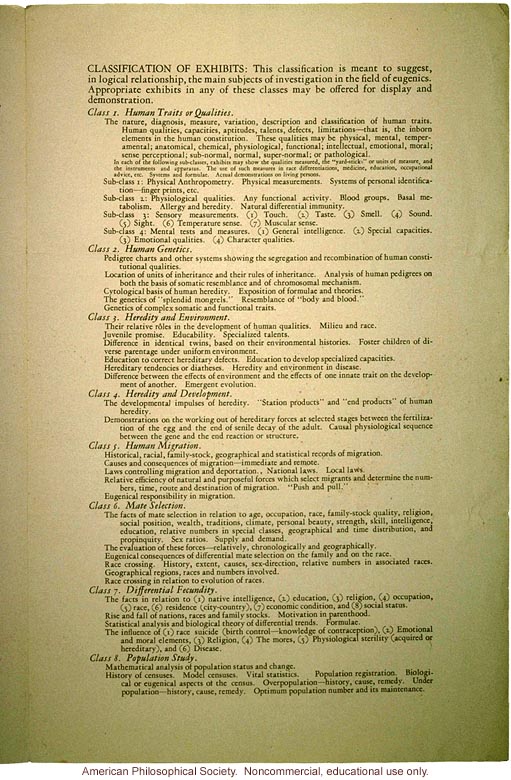The exhibit of the Third International Congress of Eugenics (2)

The exhibit of the Third International Congress of Eugenics (2)
490. Classification of Exhibits: This classification is meant to suggest, in logical relationship, the main subjects of investigation in the field of eugenics. Appropriate exhibits in any of these classes may be offered for display and demonstration. Class 1. Human Traits and Qualities. The nature, diagnosis, measure, variation, description and classification of human traits. Human qualities, capacities, aptitudes, talents, defects, limitations - that is, the inborn elements in the human constitution. These qualities may be physical, mental, temperamental; anatomical, chemical, physiological, functional; intellectual, emotional, social; sense-perceptional, sub-normal, normal, super-normal; or pathological. In each of the following sub-classes, exhibits may show the qualities measured, the "yard-sticks" or units of measure, and the instruments and apparatus. The use of such measures in race differentiations, medicine, education, occupational advice, etc. Systems and formulae. Actual demonstrations on living persons. Sub-class 1. Physical Anthropometry. Physcial measurements. Systems of personal identification - finger prints, etc. Sub-class 2. Physiological qualities. Any functional activity. Blood groups. Basal metabolism. Allergy and heredity. Natural differential immunity. Sub-class 3. Sensory measurements. (1) Touch. (2) Taste. (3) Smell. (4) Sound. (5) Sight. (6) Temperature sense. (7) Muscular sense. Sub-class 4. Mental tests and measures. (1) General intelligence. (2) Special capacities. (3) Emotional qualities. (4) Character qualities. Class 2. Human Genetics. Pedigree charts and other systems showing the segregation and recombination of human constitutional qualities. Location of units of inheritance and their rules of inheritance. Analysis of human pedigrees on both the basis of somatic resemblance and of chromosomal mechanism. Cytological basis of human heredity. Exposition of formulae and theories. The genetics of "splendid mongrels." - Resemblance of "body and blood." Genetics of complex somatic and functional traits. Class 3. Heredity and Environment. Their relative roles in the development of human qualities. Milieu and race. Juvenile promise. Educability. Specialized talents. Difference in identical twins, based on their environmental histories. Foster children of diverse parentage under uniform environment. Education to correct hereditary defects. Education to develop specialized capacities. Hereditary tendencies or diatheses. Heredity and environment in disease. Difference between the effects of environment and the effects of one innate trait on the development of another. Emergent evolution. Class 4. Heredity and development. The developmental impulses of heredity. "Station products" and "end products" of human heredity. Demonstration on the working out of hereditary forms at selected stages of fertilizationof the egg and the end of senile decay of the adult. Casual physiological sequence between the gene and the end reaction or structure. Class 5. Human Migration. Historical, racial, family-stock, geographical and statistical records of migration. Causes and consequences of migration - immediate and remote. Laws controlling migration and deportation. National laws. Local laws. Relative efficiency of material and perpetual forces which select migrants and determine the numbers, time, route and destination of migration. "Push and pull." Eugenical responsibility in migration. Class 6. Mate Selection. The facts of mate selection in relation to age, occupation, race, family-stock quality, religion, social position, wealth, traditions, climate, personal beauty, strength, skill, intelligence, education, relative numbers in special classes, geographical and time distribution, and propinquity. Sex ratios. Supply and demand. The evaluation of these forces - relatively, chronologically and geographically. Eugenical consequences of differential mate selection on the family and on the race. Race crossing. History, extent, causes, sex-direction, relative numbers on associated races. Geographical regions, races and numbers involved. Race crossing in relation to evolution of races. Class 7. Differential Fecundity. The facts in relation to (1) native intelligence, (2) education, (3) religion, (4) occupation, (5) race, (6) residence (city-county), (7) economic condition, and (8) social status. Rise and fall of nations, races and family-stocks. Motivation is parenthood. Statistical analysis and biological theory of differential trends. Formulae. The influence of (1) race suicide (birth control - knowledge of contraception), (2) Emotional and moral elements, (3) Religion, (4) The mores, (5) Physiological sterility (acquired or hereditary), and (6) Disease. Class 8. Population Study. Mathematical analysis of population status and change. History of censuses. Model censuses. Vital statistics. Population registration. Biological or eugenical aspects of the census. Overpopulation - history, cause, remedy. Under population - history, cause, remedy. Optimum population number and it maintenance.
- ID: 10484
- Source: DNALC.EA


